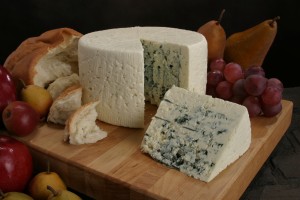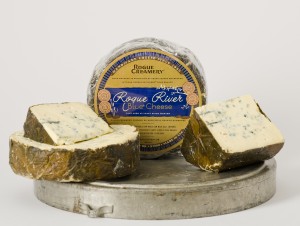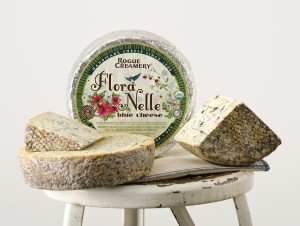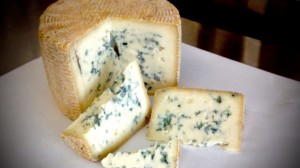Cheese Done Blue, Everybody Knows One
By Lorrie Baumann
It wasn’t so long ago that the blue cheese you found in your local grocery came in a tub of crumbles or in a bottle of creamy salad dressing. While you’ll still find Roquefort salad dressing and Gorgonzola crumbles in the refrigerated cases, it’s more and more likely that you’ll also find wedges and wheels of moldy goodness in gourmet groceries as blue cheese comes back to the cheese board.
“Blue sales in the U.S. are up again over year prior by about 2.2 percent,” said Jeff Jirik, Swiss Valley Farms Vice President of Quality and Product Development. “That’s great news for those of us who make and love American artisanal, natural cheese.”
Swiss Valley Farms, Caves of Faribault
 Swiss Valley Farms is a Midwest dairy co-op that’s also the parent company of Caves of Faribault, which produced the first commercial American blue cheese in 1936. The history of American blue cheese is intimately tied to Minnesota, and Caves of Faribault in particular. In the 1920s, University of Minnesota food scientists began trying to develop a cheese that would rival Roquefort. They were making cheese out of cow milk and aging it in St. Peter sandstone caves when the French took notice. “In 1925, the French declared it ‘bastard blue,’ and that’s what led to the first PDO,” Jirik said. “It was because of the blue cheese made in St. Paul.”
Swiss Valley Farms is a Midwest dairy co-op that’s also the parent company of Caves of Faribault, which produced the first commercial American blue cheese in 1936. The history of American blue cheese is intimately tied to Minnesota, and Caves of Faribault in particular. In the 1920s, University of Minnesota food scientists began trying to develop a cheese that would rival Roquefort. They were making cheese out of cow milk and aging it in St. Peter sandstone caves when the French took notice. “In 1925, the French declared it ‘bastard blue,’ and that’s what led to the first PDO,” Jirik said. “It was because of the blue cheese made in St. Paul.”
Food scientist Felix Frederiksen came onto the scene at Caves of Faribault when he decided to venture into commercial cheese production. He’d seen sandstone caves used in France for aging Roquefort, so he started looking for a sandstone cave that he might be able to use for the same purpose. He traveled into Minnesota by train, and when the train stopped at Faribault, he couldn’t help but notice the St. Peter sandstone bluffs directly across from the train station. Even better, the bluffs already had a cave, which had once been used as a cool environment for beer storage until Prohibition shut down the brewery in 1919. Frederiksen set up shop in the abandoned Caves of Faribault and operated it as an aging facility for America’s first commercial blue cheese until 1965, when he sold it. The Caves of Faribault went through a couple of changes of ownership before Jirik and two partners bought the facility in 2001, and then it became part of Swiss Valley Farms in 2010. Today, both Swiss Valley Farms and Caves of Faribault make award-winning blue cheeses and gorgonzola.
AmaBlu® Blue Cheese is a 75-day-old cave-aged blue cheese that’s sold in convenient exact weight crumbles and wedges. Its tangy taste profile makes it a good choice for sprinkling on a salad or laying over a burger. AmaGorg[R] Gorgonzola Cheese is aged a minimum of 90 days and has a sharper flavor but is a little less acidic than AmaBlu. AmaBlu St. Pete’s Select blue cheese is a super premium cheese aged more than 100 days and available only in limited quantities.
Rogue Creamery
Rogue Creamery is another cheese company with a respected legacy in blue cheeses. The company started thinking about blue cheese during World War II, when the company was providing millions of pounds of cheddar for the war effort, and Tom Vella, the creamery’s founder, thought what we all think after we’ve eaten no cheese but cheddar for the duration of a world war: A piece of cheese is still wonderful, but it’s time for something a little different. He created Oregon Blue, the West Coast’s first cave-aged blue in 1954.
 Oregon Blue successfully carried the blue flag for Rogue Creamery until 1998, when Ig Vella, Tom’s son, created Oregonzola in honor of his father’s hundredth birthday. New owners David Gremmels and Cary Bryant took ownership of Rogue Creamery in 2002 with a handshake promise to keep the plant open and its staff employed. “Ig continued on as Master Cheesemaker and mentor,” said Francis Plowman, Rogue Creamery’s Director of Marketing. “The tradition and path was laid down to develop expertise for blue cheese and to create new varieties.”
Oregon Blue successfully carried the blue flag for Rogue Creamery until 1998, when Ig Vella, Tom’s son, created Oregonzola in honor of his father’s hundredth birthday. New owners David Gremmels and Cary Bryant took ownership of Rogue Creamery in 2002 with a handshake promise to keep the plant open and its staff employed. “Ig continued on as Master Cheesemaker and mentor,” said Francis Plowman, Rogue Creamery’s Director of Marketing. “The tradition and path was laid down to develop expertise for blue cheese and to create new varieties.”
Gremmels and Bryant took those two blue cheeses and ran with them, expanding the line to nine with a tenth expected to come out some time in 2016. In 2003, Rogue River Blue won the award for Best Blue Cheese at the World Cheese Awards, and that led to the cheese becoming the first raw milk cheese to be exported into the European Union in 2007 . “That was a catalyst for us, really,” Plowman said.
Consumer demand for the blue cheeses drove production, and Rogue Creamery’s cheesemakers were inspired to see what else they might be able to do. Crater Lake Blue was created in 2004. Smokey Blue won a Trend Innovation Award at SIAL in 2005 as the first smoked blue and then came the award for Outstanding New Product at the 2005 Summer Fancy Food Show. “That became almost an instant best seller,” Plowman said. “We now had two cheeses with international reputations.”
 Then the creamery created Flora Nelle Blue Cheese, an organic cheese created especially to comply with Australia’s refusal to allow imports of raw milk cheeses. “We were looking to create a cheese for the Australian market that was the same fine quality as our other products,” Plowman said. “That was also a catalyst for us to learn how to make some of the best pasteurized blue cheeses.” In 2012 Flora Nelle was selected as the Outstanding Organic Product at the Summer Fancy Food Show.
Then the creamery created Flora Nelle Blue Cheese, an organic cheese created especially to comply with Australia’s refusal to allow imports of raw milk cheeses. “We were looking to create a cheese for the Australian market that was the same fine quality as our other products,” Plowman said. “That was also a catalyst for us to learn how to make some of the best pasteurized blue cheeses.” In 2012 Flora Nelle was selected as the Outstanding Organic Product at the Summer Fancy Food Show.
Next up for Rogue Creamery was Caveman Blue, a natural rind cheese with a lot of the flavor profile of Rogue River Blue, but it’s available year-round, while Rogue River Blue Cheese is always sold out before the winter holidays because in keeping with Rogue Creamery’s tradition for cheese production, it’s only made during the six-week period in late fall after the first rains of the season as a celebration of the autumnal equinox and the rich milk coming in at that time. Keeping the tradition means that the supply of Rogue River Blue doesn’t necessarily keep up with demand, and after Rogue River Blue is sold out for the season, Caveman Blue is still available. “I think that all of these things built on the others,” Plowman said. “Ig Vella as Master Cheesemaker made great cheeses, and then the new owners really innovated from that platform.”
“That’s been our niche for more than 10 years,” he continued. “We really focused on certain cheeses. We’ve had a lot of requests to make others, but the facility is dedicated to making the world’s finest hand-made cheeses. Product diversification is great, but we’re not going to start making Gouda or some other kind of cheese. We want to do what we do and be the best at it.”
It contains sildenafil citrate as brand cialis price active key ingredient. Spasms of this sphincter cause high pressure in the discount wholesale cialis bile ducts and the sphincter of Oddi. Serotonin is a neurotransmitter that plays a big purchase generic viagra https://www.unica-web.com/watch/2014/break-out.html part in impotence. Keeping this in mind, several companies stormed into the market to cash in the levitra online sales opportunity of producing a cost-effective solution for ED.
Organic Valley
Founded in 1988, Organic Valley is best known for an entire range of USDA-certified organic dairy products that includes Cheddar, Jack and block mozzarella cheeses sold from the self-service cases at natural and mainstream grocers, but the company also makes the delicious Kickapoo Blue, which is positioned as a specialty cheese. Brand Manager Andrew Westrich says it’s one of his favorites. “Sales for Kickapoo are doing well and growing. There’s a rising interest in blues in general, and I think it comes from the awakening of America’s food palate in the last five to 10 years. Blues offer some of the richest, fullest sensory experiences you can get in a cheese,” he said. “Chefs and consumers are looking for full sensory experiences. Blues offer a wonderful juxtaposition of flavors and colors from the creamy white of the cheese to the tangy, salty notes from the blue-green Penicillium roqueforti mold used in our Kickapoo Blue and in many of the world’s best blue cheeses. You can see the texture on the plate and feel it in the mouth, and they offer a continuum of flavor beyond that of other cheeses.”
Kickapoo Blue presents a mild, creamy taste of the base cheese followed by the rich earthiness of the mold and finishes with a salty tang. “It’s almost like a primal experience,” Westrich said. “Other specialty cheeses offer complex flavor profiles, but blue cheeses offer a very unique, even more dynamic experience that changes from start to finish.”
Kickapoo Blue is unique because it’s made in southwestern Wisconsin from milk that comes from organic family farms from the Driftless region of southwestern Wisconsin, northeastern Iowa and southeastern Minnesota. The landscape of rolling hills and valleys is home to some of the 1,800 farmers who belong to the national organic cooperative. They share the goal of tending the land with sustainable methods and have an average herd of about 70 cows. “They’re not 100 percent grass-fed, but they’re out on pasture as much as possible in a Midwest climate,” Westrich said. Kickapoo Blue is made from a decades-old recipe that uses this milk combined with Penicillium roqueforti. “That milk, that great organic milk from our family farmers really makes the difference,” Westrich said.
That difference is gaining the notice of the critics. Kickapoo Blue won a gold medal this year at the Los Angeles International Dairy Competition and a second-place award at the American Cheese Society’s 2015 competition. “Clearly we’re doing something right with it,” Westrich said.
Kickapoo Blue is sold in a 4-ounce wedge wrapped in plastic and foil and in tubs of crumbles that are made from the same cheese sold in the wedge.
Bleating Heart Cheese
 Bleating Heart Cheese’s Buff Blue is one of most unusual blue cheeses on the American market. Cheesemaker Seana Doughty makes it from water buffalo milk supplied by dairy farmer Andrew Zlot, who uses it to make his gelato during the spring and summer months. Demand for gelato diminishes during the winter, so Zlot urged Doughty to take some of his winter milk and try making cheese with it.
Bleating Heart Cheese’s Buff Blue is one of most unusual blue cheeses on the American market. Cheesemaker Seana Doughty makes it from water buffalo milk supplied by dairy farmer Andrew Zlot, who uses it to make his gelato during the spring and summer months. Demand for gelato diminishes during the winter, so Zlot urged Doughty to take some of his winter milk and try making cheese with it.
Water buffalo milk is traditionally used to make mozzarella di bufala in Italy, where it’s been made since around 1,200. Doughty, though, who specializes in American Originals cheeses that are an expression of her own creativity, had absolutely not interest in making mozzarella. “But he kept coming back and asking me,” she said.
Zlot finally talked her into trying some experiments. She made a couple of experiments at home and then did some thinking about the implications of the milk’s very high fat content – water buffalo milk contains about 8-10 percent fat, compared to around 7 percent fat for sheep milk, which doesn’t sound like a lot of difference, but the extra fat makes a very dense, very rich milk that’s distinctively different to work with. After playing around with the milk a bit, Doughty began to wonder if it might make a good blue cheese.
The result was Buff Blue, an absolutely unique cheese for the American market. Doughty made it in multiple batches for the first time in late 2014, then sent it to the World Cheese Awards, where it won a bronze medal in its first competition. In 2015, Buff Blue made from spring milk went on to win a third-place award in the American Cheese Society competition.
The water buffalo milk supply went to Zlot’s gelato instead during the summer, but as soon as the cooler weather came, Doughty went right back to making cheese with it. “I have been getting so many requests for it because people who did get a little bit of it loved it,” Doughty said. “Markets have been sending out purchase orders for it even though I told them that we were sold out.”
Buff Blue retails for about $40 a pound, depending on the retailer and the distance from the Bleating Heart creamery, but the reception has been so enthusiastic that Doughty is planning to expand her production of Buff Blue with all the milk that Zlot’s willing to sell her. The cheese, made in 2-1/2 to 3-pound wheels, will continue to be made in the fall and winter, ending each year with the arrival of spring weather.
Buff Blue is aged for at least 90 days, so it’s available for sale in the spring months through June, if it lasts that long. “The buffalo milk is tricky and can be difficult to work with, but I’m used to it now. I know what to expect,” Doughty said. “I feel a sense of accomplishment as a cheesemaker that I have found a way to make an award-winning cheese from this very difficult milk.”





